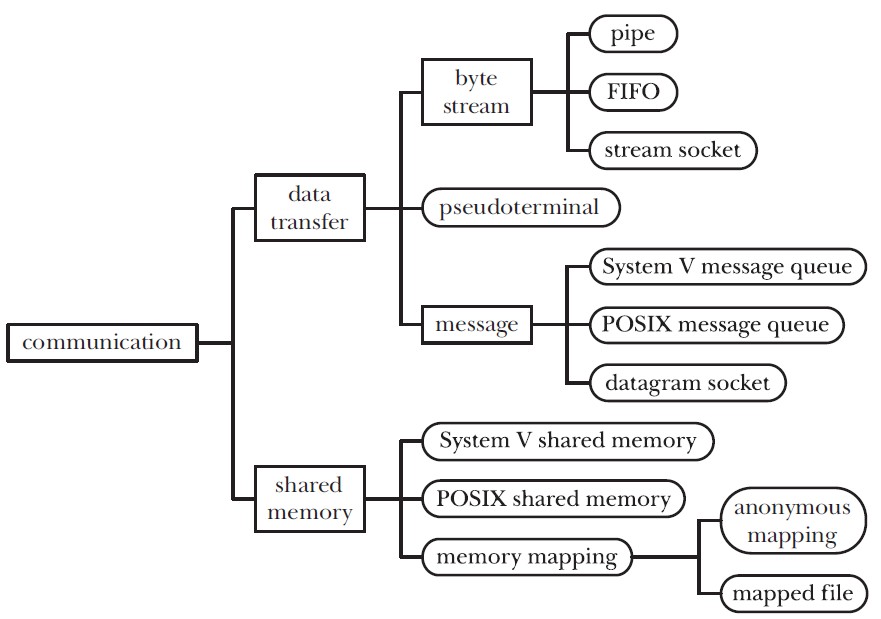Introduction to Interprocess Communication
OS Laboratory Team
Fall 2018- Taxonomy of IPC Facilities
- Comminucation
Taxonomy of IPC Facilities
- Comminucation
- Synchronization
- Signals
- Communication
- These facilities are concerned with exchaning data between processes
- Synchronization
- These facilities are concerned with synchronizing the actions of processes or threads
- Signals
- Although signals are intended primarily for other purposes, they can be used as a synchronization technique in certain circumestances

Comminucation
- Pipes
- FIFOs
- Shared Memory
The various comminucation facilities allow processes to exchange data with one another
- Data-transfer facilities
- The key factor distinguishing these facilities is the notion of writing and reading. In order to communicate, one process writes data to the IPC facility, and another process reads the data
- Shared memory
- Shared memory allows processes to exchange information by placing it in a region of memory that is shared between the processes. Shared memory can provide very fast comminucation because it doesn't require system calls or data transfer between user and kernel memory.
DPDK is a set of libraries and drivers for fast packet processing

We can further break data-transfer facilities into the following subcategories
-
Byte Stream
- pipes
- FIFOs
- stream sockets (TCP)
-
Message
- System V message queue
- POSIX message queues
- datagram sockets (UDP)
- Pseudoterminals
Let's code :)
Pipes as a Byte Stream Data Transfer Facility
#include <unistd.h>
int pipe(int filedes[2]);
/*
* Returns 0 on success, or -1 on error
*/
#include <stdio.h>
FILE *popen(const char *command, const char *mode);
/*
* Returns file stream or NULL on error
* mode is w: calling process write to command
* mode is r: calling process read from command
*/
int pclose(FILE *stream);
/*
* Returns termination status of child process, or -1 on error
*/
Separating messages in a byte stream:
- delimiter character
- header with length field
- fixed-length messages
Synchronization between the reader and writer processes is automatic
Let's code :)
FIFOs as a Byte Stream Data Transfer Facility
FIFOs == Named pipes !
#include <sys/stat.h>
int mkfifo(const char *pathname, mode_t, mode);
/*
* Returns 0 on success, or -1 on error
*/
Although shared memory provides fast communication, this speed advantage is offset by the need of synchronize operations on the shared memory.
Redis is an open source (BSD licensed), in-memory data structure store, used as a database, cache and message broker.

Let's code :)
Shared Memory :|
| shm API | description |
|---|---|
| shmget | allocate shared memory segment |
| shmat | attach to the shared memory with the given shared memory identifier |
| shmctl | perform control operations on the shared memory segment |
| shmdt | detaches from the shared memory |
To use the above API we must include
<sys/ipc.h> and
<sys/shm.h> header files.
int shmget(key_t key, size_t size, int shmflg);
shmget returns the shared memory ID on success.
- The first argument
keymust be unique. Thiskeycan be generated using theftok()call. - The
sizeargument is the size of the shared memory segment (it is rounded to the multiples of PAGE_SIZE. Usually PAGE_SIZE is 4k). - The
shmflgis usually set with the IPC_CREAT flag. - If the
keyalready exist, theerrnois set to EEXIST and returns -1.
ICPS !?
ipcs - show information on IPC facilities
- -m, --shmems
- Write information about active shared memory segments.
- -q, --queues
- Write information about active message queues.
- -s, --semaphores
- Write information about active semaphore sets.
- -a, --all
- Write information about all three resources (default).
void *shmat(int shmid, const void *shmaddr, int shmflg);
The API shmat performs the attachement to the shared memory segment.
- the first argument
shmidis the id returned from shmget. - the second argument is the attach address, and is usually kept to NULL.
- the shmflg is also kept to 0 when doing read and write operations on the shared memory.